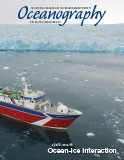Article Abstract
The most rapid loss of ice from the Antarctic Ice Sheet is observed where ice streams flow into the ocean and begin to float, forming the great Antarctic ice shelves that surround much of the continent. Because these ice shelves are floating, their thinning does not greatly influence sea level. However, they also buttress the ice streams draining the ice sheet, and so ice shelf changes do significantly influence sea level by altering the discharge of grounded ice. Currently, the most significant loss of mass from the ice shelves is from melting at the base (although iceberg calving is a close second). Accessing the ocean beneath ice shelves is extremely difficult, so numerical models are invaluable for understanding the processes governing basal melting. This paper describes the different ways in which ice shelf/ocean interactions are modeled and discusses emerging directions that will enhance understanding of how the ice shelves are melting now and how this might change in the future.

